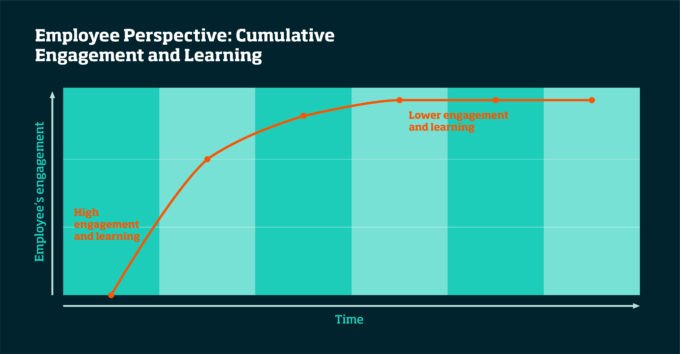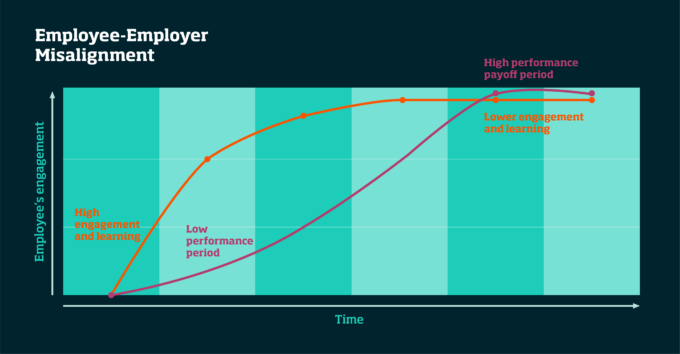
Stress busters: How to help employees help themselves
Dr. Rachel Lewis explores how empowering teams to co-create solutions can reduce workplace stress and boost wellbeing...

by Michael Yaziji, Peter Firnhaber Published June 16, 2023 in Management • 3 min read
Business success often hinges on the delicate balance between the growth and satisfaction of employees and the performance of the company. However, there is an inherent misalignment between the interests of individual employees and those of the wider organization. By understanding and embracing this tension, managers can find creative solutions, leading to surprising outcomes that benefit both parties in terms of higher job satisfaction, engagement, and productivity levels.
Consider the employee’s perspective, specifically around learning and engagement over time, represented in the graph below. The curve begins steeply, reflecting the excitement and learning that occurs during the early years of a new job (downward curve). This period, rich in novelty and challenge, fuels a basic human need for engagement and learning (and results in higher future earning potential). As soon as the curve starts leveling off, it may be time for workers to seek new learning opportunities and challenges in another company?

By contrast, the employer will be more concerned with performance. The worker’s output is best represented by an upward curve, as it starts low and increases over time as they master their role. The early years of employment are viewed by the business as an investment in building a worker’s competence, while the later years are when that investment pays dividends.

A profit-seeking enterprise will naturally want to invest as little as possible upfront and reap the rewards for as long as possible, but this can create tension with employees. While the beginning of their job is the most invigorating part, for the employer this period can be seen as a cost, owing to lower individual performance. By contrast, once an employee has reached full productivity, their enjoyment of work usually tails off, but this is the payoff period for the employer.

Of course, workers can find security and fulfillment in their job if they feel competent and secure – even after years in the role. And forward-thinking companies understand the importance of nurturing their employees over the longer term, if they can keep hold of them; it increases motivation, which then drives productivity, enhances job satisfaction, and promotes creativity and innovation. But the challenge for managers is finding the right balance between the priorities of staff and those of the wider organization.
Take the case of Susan, a high-performing sales manager at a large corporation. After six years, Susan’s engagement began to wane and she considered making a career change. However, her company was reluctant to lose a valuable asset with years of experience. The solution was to allow Susan to take on new responsibilities alongside her core role. This was a win-win because it gave Susan the challenge she craved while the company retained her expertise.
This scenario underscores the importance of managers acknowledging and embracing the tension between individual employee growth and company performance. By doing so, both parties can collaborate to find innovative solutions that satisfy their respective needs.
In the early days in a new role, organizations should try to help accelerate a new joiner’s performance. One approach is to offer on-the-job training with an outgoing mentor. This serves to help them get up and running sooner and is also a way to keep the departing employee engaged.
In addition, managers can create a culture of continuous learning, or a commitment to ongoing development, by encouraging learning on a daily basis to keep excitement levels up even as employees mature in their role. By promoting a culture that values personal growth and adaptation, companies can transform potential conflicts into a driving force for long-term success, for both employee and employer.
The tug-of-war between employee growth and company performance is an inherent aspect of modern business. Rather than avoiding this tension, organizations and their employees should embrace it, using the friction as a catalyst for creative solutions that benefit both parties.

Michael Yaziji is an award-winning author whose work spans leadership and strategy. He is recognized as a world-leading expert on non-market strategy and NGO-corporate relations and has a particular interest in ethical questions facing business leaders. His research includes the world’s largest survey on psychological drivers, psychological safety, and organizational performance and explores how human biases and self-deception can impact decision making and how they can be mitigated. At IMD, he is the co-Director of the Stakeholder Management for Boards training program.

MBA, Executive Coach, Coaching Supervisor
Peter Firnhaber is a global executive coach and consultant, operating in Europe, Asia, USA and the Middle East. He manages his executive coaching and consulting company, based in Zurich. He is also a practicing coaching supervisor working with coaches from across the globe.His coaching approach is systemic, utilizing individual, group and organizational aspects to address his coachee’s concerns. He has experience in coaching executives at all levels of organizations from CEOs and senior leadership teams, through senior managers, middle management and high potential candidates. Over the last 18 years, Peter has worked with many industries including automotive, manufacturing, IT, financial services, energy, hospitality and pharma, across three continents.

June 23, 2025 • by Rachel Lewis in Human Resources
Dr. Rachel Lewis explores how empowering teams to co-create solutions can reduce workplace stress and boost wellbeing...

May 13, 2025 • by Luca Condosta in Human Resources
The CDO, formerly a figurehead for regulatory compliance, is now a key driver of company strategy. Luca Condosta describes the essential skills that CDOs require to turn DE&I concepts into actual commercial...

April 30, 2025 • by Manju Ahuja in Human Resources
The pandemic sparked a shift to remote work that’s proving hard to reverse. According to Prof. Manju Ahuja, hybrid models are the new norm—driven by employee expectations, technological advances, and a changing...

April 29, 2025 • by Michael D. Watkins in Human Resources
Use this diagnostic tool and roadmap to rebuild trust and confidence within dysfunctional teams – the first crucial steps toward a future of high performance....
 Audio available
Audio availableExplore first person business intelligence from top minds curated for a global executive audience